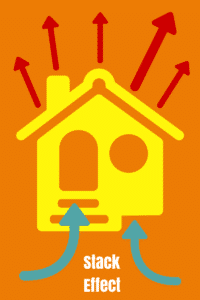 You thought You Knew How Air Flows in Your House – Stack Effect
You thought You Knew How Air Flows in Your House – Stack Effect
“Wait. I thought heat rises?” Paula eyed our energy consultant suspiciously, as if she’d caught him in a whopper. “Everybody knows that. I learned it in high school.” Like many people, Paula did not know about the stack effect.
This is a common misconception. While heat does in fact rise, that’s not all that heat does. Heat moves from areas of higher temperature to areas of lower temperature, which means that wherever you’ve got cooler air – up, down, or sideways, heat is going there.
In addition, the movement of air is influenced by its density. Think about a mass of people on a beach in their bathing suits. When the weather is hot, they’ll want more space between them, so they’ll spread out to enjoy the sun. When it’s cold, they’ll huddle together for body heat. Likewise, when air becomes heated, its molecules spread out and take up more space, which means it has a lower density. Cold air is more dense than warm air.
Warm air rises when it’s surrounded by cold air because of its lower density. In your home, this is called the stack effect, and it’s the reason your home leaks when inside and outside temperatures are vastly different. If you’ve ever climbed into your attic in the winter and felt the warm air from your heated living space push past you, you’ve experienced the stack effect first hand.
In the winter, the warm air inside your house, which is heated by your furnace, does rise, and it will seep through any leaks that it can find in your attic in order to escape into the more dense, colder air outside.
In the summer, however, the densest air can be found in your home, thanks to your air conditioning. During the hottest months, warm air leaks down through the very same cracks and gaps in the attic that allow it to escape in the winter, displacing the cooler air and pushing it out through any leaks in your flooring.
So you see, though heat does rise, it is capable of much more than rising. Understanding the stack effect is the first step in understanding the importance of an air sealed home. Just by preventing heat from making its grand entrance in the summer and its great escape in the winter, you could reduce your utility bill and increase the comfort of your home drastically, just like Paula did.
If you’re interested in seeing how the stack effect is impacting your home’s energy performance, give Sunlight Contractors a call and schedule a free home energy audit. We can pinpoint exactly where your home is losing conditioned air through leaks, and then we can make a plan to seal up those leaks.
Locations:
Main Office: Sunlight Contractors, LLC 2323 Bainbridge St #110, Kenner, LA 70062 (504) 919-9993
New Orleans location: Sunlight Contractors, LLC 650 Poydras St, Suite 1400, Rm 33, New Orleans, LA 70130 (504) 302-0058
Proudly Serving the following areas:

 You thought You Knew How Air Flows in Your House – Stack Effect
You thought You Knew How Air Flows in Your House – Stack Effect